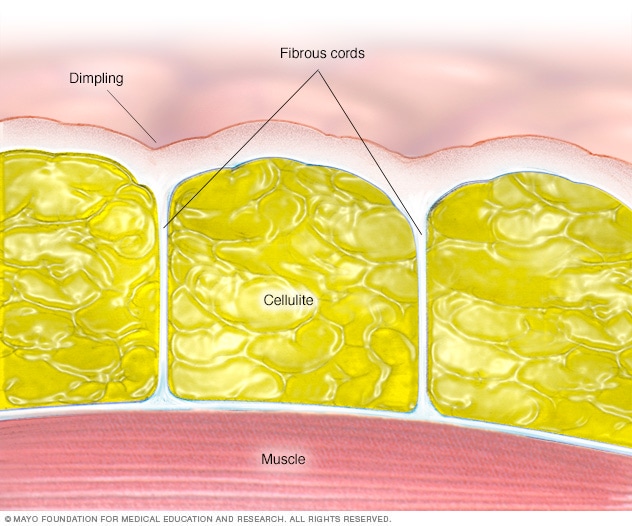Overview
Anatomy of cellulite

Anatomy of cellulite
As fat cells increase, they push up against the skin. Tough, long connective cords pull down. This creates an uneven surface or dimpling, often referred to as cellulite.
Cellulite is a very common, harmless skin condition that causes lumpy, dimpled flesh on the thighs, hips, buttocks and abdomen. The condition is most prevalent in women.
Many people try, with variable success, to improve the appearance of their skin through weight loss, exercise, massage and creams marketed as a solution to cellulite. Medically proven treatment options are available as well, though results aren't immediate or long lasting.
Products & Services
Symptoms
Cellulite looks like dimpled or bumpy skin. It's sometimes described as having a cottage cheese or orange peel texture.
You can see mild cellulite only if you pinch your skin in an area where you have cellulite, such as your thighs. Cellulite that is more severe makes the skin appear rumpled and bumpy with areas of peaks and valleys.
Cellulite is most common around the thighs and buttocks, but it can also be found on the breasts, lower abdomen and upper arms.
When to see a doctor
Treatment isn't necessary. But if you're concerned about the appearance of your skin, talk with your primary care doctor or a specialist in skin diseases (dermatologist) or plastic surgery about treatment options.
Causes
Little is known about what causes cellulite. It involves fibrous connective cords that tether the skin to the underlying muscle, with the fat lying between. As fat cells accumulate, they push up against the skin, while the long, tough cords pull down. This creates an uneven surface or dimpling.
In addition, hormonal factors play a large role in the development of cellulite, and genetics determine skin structure, skin texture and body type. Other factors, such as weight and muscle tone affect whether you have cellulite, though even very fit people can have it.
Risk factors
Cellulite is much more common in women than in men. In fact, most women develop some cellulite after puberty. This is because women's fat is typically distributed in the thighs, hips and buttocks — common areas for cellulite. Cellulite is also more common with aging, when the skin loses elasticity. Weight gain can make cellulite more noticeable, but some lean people have cellulite, as well. It tends to run in families, so genetics might play the biggest role in whether you develop cellulite. An inactive lifestyle also can increase your chances of having cellulite, as can pregnancy.
Nov. 21, 2023